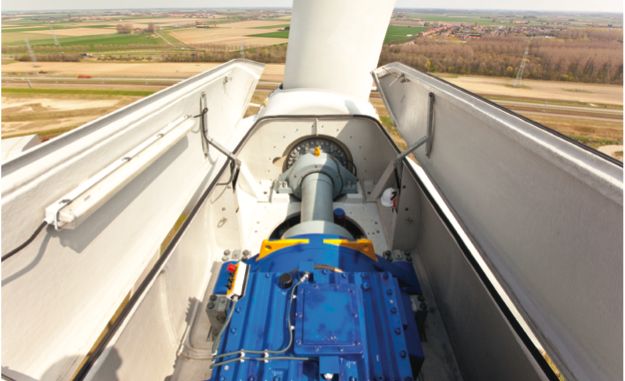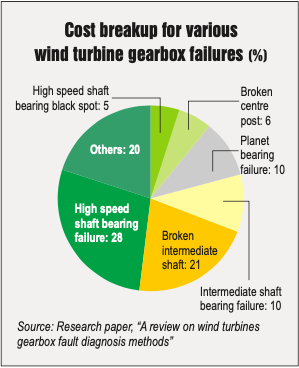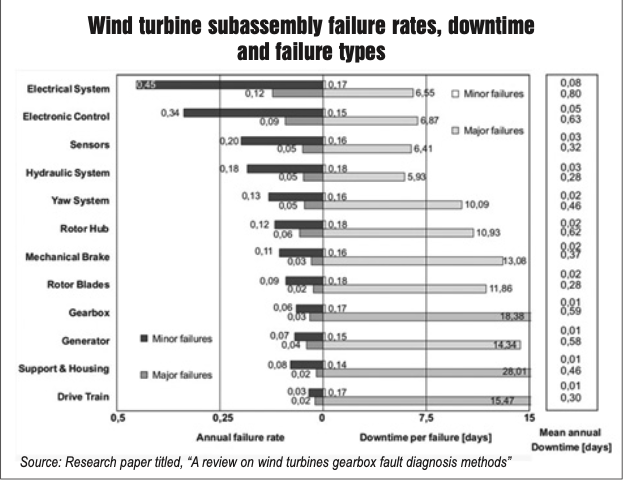
Wind power deployment is growing rapidly across the world, aided by the climate action commitments and energy mix diversification strategies of various countries. Two types of wind turbines are the primary focus of innovation efforts across the globe: gearboxes and direct-drive wind turbines. Over the years, gearbox-based wind turbines have evolved, leading to the variable speed wind turbine with a multistage gearbox, which has a gearbox between the low speed rotor and a higher speed electrical generator to increase the rotational rotor speed. However, gearbox-based wind turbines have many moving parts, which are quite prone to mechanical stress and strain. Thus, they must be adjusted, lubricated and maintained to prevent failures and deposition of dirt and moisture.
To avoid such gearbox-related maintenance issues, variable speed direct-drive wind turbines have been introduced that do not have gearboxes, with the synchronous generator being directly powered by the rotor. Since the rotational speed is low, several magnetic poles are placed in the generator for high output. These types of wind turbines normally use permanent magnet generators (PMGs) or electrically excited synchronous generators (EESGs). Unlike PMGs, EESGs do not have permanent magnets made from rare materials. PMGs are smaller and lighter than EESGs.
 Direct-drive wind turbines offer various advantages such as quiet operations due to less mechanical noise, and reduced operations and maintenance costs due to fewer rotating components. However, these turbines require heavier and larger generators to make up for the high torque requirements. Thus, when the turbine capacity is large, a single- or two-stage gearbox would be the preferred option. To this end, there has been focused development of lighter direct-drive turbines. Further, the price of permanent magnets has dropped over the years, making a strong case for PMG turbines.
Direct-drive wind turbines offer various advantages such as quiet operations due to less mechanical noise, and reduced operations and maintenance costs due to fewer rotating components. However, these turbines require heavier and larger generators to make up for the high torque requirements. Thus, when the turbine capacity is large, a single- or two-stage gearbox would be the preferred option. To this end, there has been focused development of lighter direct-drive turbines. Further, the price of permanent magnets has dropped over the years, making a strong case for PMG turbines.
However, the fact remains that gearbox-based turbines have dominated the wind market for decades, with thousands of such turbines already deployed or being installed to serve their 25-year project life. Thus, the focus of many manufacturers is on improving efficiencies through advanced gearboxes that are less prone to outages, optimising O&M practices to prevent failures altogether, or diagnosing and correcting errors before a fault can occur. A look at the common gearbox faults and ways to diagnose them.
Common gearbox faults
Bearings are one of the essential components of a turbine, and a typical wind turbine has many of these working continuously for many years. They are thus susceptible to failures, leading to unplanned maintenance and repair costs. The Gearbox Reliability Database (GRD), prepared by the National Renewable Energy Laboratory (NREL), shows that gearbox failures due to bearings are significantly higher than those due to gear issues. Thus, there is a strong focus on making tougher and more reliable bearings. According to NREL’s GRD, there are five common failures that occur in wind turbine bearings:
- Axial cracking: A crack in the axial direction or white etching cracks due to improper fits, improper shaft grooving, rotation of rings and microstructural alterations in bearing material
- Scuffing/Smearing: An adhesive wear due to frictional heating during material transfer from one surface to another
- Spalling: Pitting and flaking of material
- Micropitting: Deformation and break-off due to insufficient lubrication
- Dents: Caused due to lubricant contamination
Turbine gearboxes are susceptible to other failures such as shaft imbalance, shaft damage, gear damage and lubrication-related issues. In addition, the generator itself is prone to faults due to its constant operation in an electromagnetic environment. These include excessive vibration, overheating, abnormal noises and insulation damage. Similarly, braking systems can get damaged due to failures within the hydraulic unit.
Fault diagnosis
Since gearboxes are prone to a number of faults that are time-consuming to rectify and can lead to significant downtime and revenue losses, it is important to have proper methods to diagnose these faults and prevent cost implications. According to a research paper titled, “A Review on Wind Turbines Gearbox Fault Diagnosis Methods”, by Gu H., Liu W. Y., Gao Q. W. and Zhang Y, published in the Journal of Vibroengineering, many solutions have been identified for proper fault diagnosis in wind turbine gearboxes, which promise attractive results. Some of these are briefly discussed below:
Time frequency analysis: This method aims to process the signals collected by the vibration acceleration sensor. The method of signal processing is of key importance here, as it impacts analysis. Diagnosis results are also impacted by the specific test conditions, as one method would not be suitable for all wind projects.
CMS performance methods: Condition monitoring systems basically predict possible faults based on certain specific conditions and issue alerts accordingly. Thus, data is first collected and analysed. The system is then trained to recognise normal behaviour, so that it can raise an alarm in case of any abnormal events. Thus, the trained system can predict anomalies in case of specific events, which can then be checked and rectified beforehand, helping prevent system downtime.

Intelligent fault diagnosis methods: Intelligent fault diagnosis combines conventional fault diagnosis methods with advanced artificial intelligence (AI). With high-level innovations taking place in the AI and machine learning space every day, there is an immense opportunity for integrating them in wind turbine diagnostics and improving equipment efficiency. The self-learning and adaptive capabilities of such software, implemented on the volumes of monitoring data collected during project operations, can help minimise downtime risks significantly.
Even with these fault diagnosis methods, key factors need to be kept in mind to improve the analysis and its results. For instance, the placement of the sensors that provide the O&M data is quite critical. Further, correct identification of the faulty equipment or feature is important. For this, it is important that the vibration signal is not polluted by background noise, and this can be avoided through an effective algorithm. Moreover, the condition-based drawbacks associated with fault detection methods need to be rectified.
Outlook
The wind industry is heavily dependent on gearboxes, which are some of the most complicated equipment in a turbine. As direct-drive turbines also have a few drawbacks, gearbox-based turbines will continue to be manufactured and deployed. Thus, it is imperative to address the prevalent issues in gearboxes and make them more efficient. Further, advanced O&M techniques that use data analytics and AI-enabled tools to improve cost efficiency need to be incorporated in daily operations.
By Khushboo Goyal



